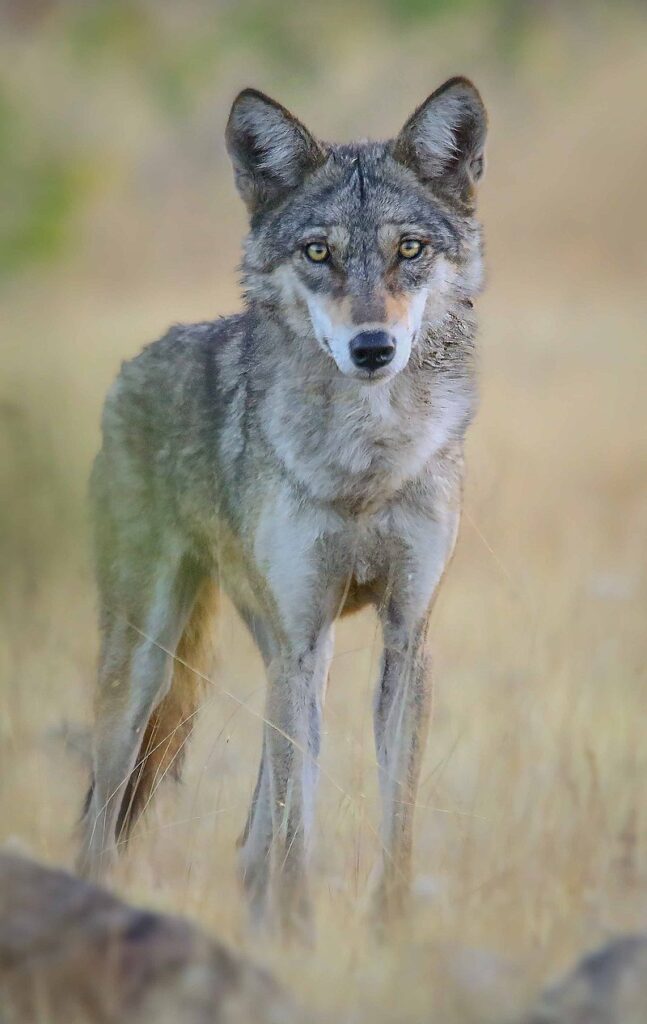Descendants of one of the oldest lineages of wolves, the Indian grey wolf (Canis lupus pallipes) is an apex predator present in grasslands across the Indian subcontinent. However land conversion and encroachment has pushed them to the brink of extinction. India certainly needs to reverse the loss of her grasslands. These pack-dwelling, loyal animals seem to have pulled the shortest straw when it came to survival, leaving them with fragmented populations and dwindling numbers.
Tawny coloured, with a white under belly and streaks of black on their backs, these medium-sized, slender canids are found in some of the hottest ecosystems – grasslands, thorn forests and scrublands. Their short, thin fur helps them survive heat waves in the summer. Monogamous in nature, these wolves travel, live and hunt in packs, with whom they share a strong bond. These pack dynamics determine territoriality and thus meta-population structures.

What threats does the Indian Grey Wolf face?
Habitat Fragmentation
Large scale habitat fragmentation in grassland scapes has led to isolation of these populations from one another, causing reduced genetic diversity. It has also brought them in contact with feral dogs inhabiting these small patches. Cross-species mating and close proximity with the latter has been thought to cause canine distemper, parvovirus and other illnesses that have the potential to wipe out entire populations of wolves.
Increased Interactions with Leopards also a threat
Besides this seemingly small problem, wolves also have to work against larger forces, namely humans and leopards. Ironically, their fight with leopards comes from afforestation and green-projects, where in order to reintroduce tree cover, grasslands are converted into forests or large scale agricultural lands. Leopards move into these areas because they find it easier to hide and hunt for prey in such landscapes.
Their presence automatically removes wolves from the web, who relinquish their position as the apex predator in the ecosystem. Another aspect of concern is that as part of the bush-meat trade, there has been rampant hunting of wolves’ prey too, such as the mongoose, hare, fowl and partridge, leaving the wolves starved for food. Forced into living in agricultural interstices, wolves depend on livestock as prey, which has unsurprisingly led to increasing instances of wildlife-human conflicts.
But isn’t the Indian Grey Wolf a protected species?
Having noticed the declining numbers, The Schedule I of the Indian Wildlife Protection Act of 1972 named Indian grey wolves as an endangered species. However, this did not help matters, for the habitats occupied by the species fall outside of the protected area i.e., in agro-pastoral habitats.
The most common issue with respect to protection of wolf populations is the lack of knowledge on the topic and these magnificent creatures. Labelled as vermin from pre-colonial times, wolves have had to endure uncalled for dislike from humans. Having encroached their habitats, humans have proceeded to erase wolf populations completely.
Why is the conservation of the Indian Grey Wolf so important?
Why is this an important issue? I would like to bring forth one of the most famous examples of trophic cascades – the case of missing wolves from the Yellowstone National Park, USA. In an eerily similar situation, unregulated shooting and elimination of wolves from the National Park led to a drastic change in the ecosystem, from green-covered scrublands with rivers flowing through them, to a dry, barren thorn-covered landscape.
The removal of wolves due to human actions had allowed for elk populations to grow unchecked, which in turn had wiped out greenery from the system. Realising the folly in the series of actions, wolves were reintroduced to the park, which then immediately showed a true for the better. As apex predators in the grassland systems of India, the grey wolf plays a pivotal role in regulating the population of smaller predators and herbivores, employing what is known as the top-down control. It is this form of regulation that allows for the presence of a green world, the removal of which might have dire consequences on the ecosystem.
Conclusions
Kipling’s Jungle Book painted wolves as a social species that raised, cared for and protected Mowgli. However, in the current times, wolves are severely looked down upon. More often than not, more charismatic animals such as tigers, cheetahs or rhinos pull attention away from other critically endangered animals such as the Indian grey wolf. Without protective programs such as the ones being conducted by WTI and Wild Canids, wolf numbers would have dropped far below the estimate of 1,500 – 2,000.
Their biggest challenges lay in raising awareness and changing the viewpoint people hold regarding the presence and importance of these beasts in the ecosystem. The Indian subcontinent is thought to be one of the hubs of canid diversity, the bracket into which the grey wolves fall. While threatened by humans, their only hope seems to be humans as well, a role we might have to take more seriously, sooner rather than later for fear of losing the species entirely.
Help us help them! Think Wildlife Foundation is a non profit organization with various conservation initiatives. Our most prominent campaign is our Caring for Pari intiative. Pari is a rehabilitated elephant at the Wildlife SoS Hospital. 25% of the profits from our store are donated to the elephant hospital for Pari. Other than buying our wonderful merchandise, you could donate directly to our Caring For Pari fundraiser.
Written by: Samanvitha Santusht
References:
- https://roundglasssustain.com/species/indian-grey-wolf
- https://india.mongabay.com/2022/03/counting-indias-wolves-one-howl-at-a-time/
- https://www.thehindu.com/sci-tech/energy-and-environment/indias-missing-wolves/article65421926.ece
- https://journals.plos.org/plosone/article?id=10.1371/journal.pone.0215019
- https://bioone.org/journals/mammal-study/volume-47/issue-1/ms2021-0029/Factors-Influencing-Habitat-Use-of-Indian-Grey-Wolf-in-the/10.3106/ms2021-0029.short
